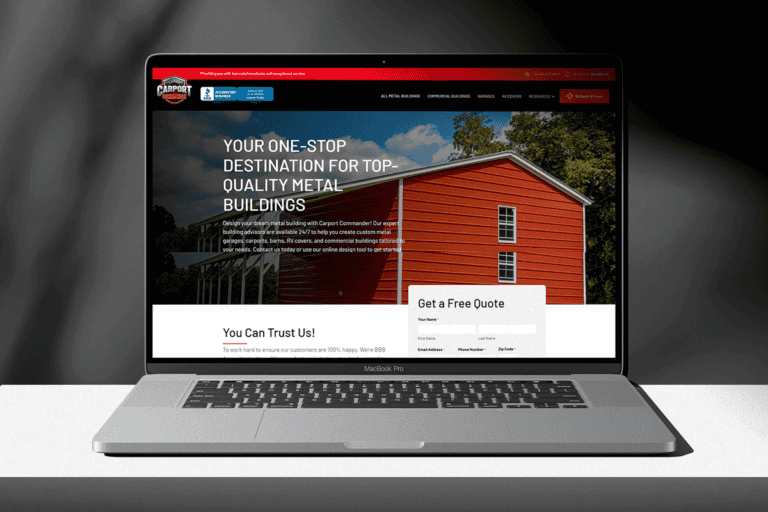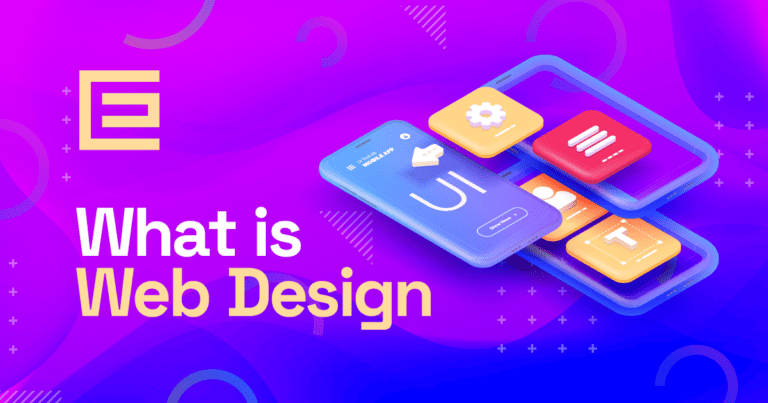In today’s digital world, mobile website design is absolutely crucial. It’s all about crafting websites that look great and work smoothly on mobile devices like smartphones and tablets. What’s really important here is adaptability – making sure that everything from text to images adjusts perfectly to different screen sizes and ways you hold your device. At the heart of it, mobile website design is about putting the user first. It’s about making sure everyone has a great experience browsing, no matter what device they’re using.
Why Mobile Website Design Really Matters
Let’s face it, mobile website design has been a big deal for awhile. Just look around – everyone’s glued to their smartphones and tablets, right? That’s where a huge chunk of internet browsing happens now.
So, if your website isn’t playing nice with mobile devices, you’re missing out big time. It’s no longer just a cool trend; it’s a must-have. A mobile-friendly website opens your doors to way more people, keeps them hooked, and makes their experience a whole lot better.
Plus, let’s not forget how important it is for your site to rank well on search engines – and guess what? They love mobile-friendly sites. So, really, nailing your mobile website design isn’t just about looking good; it’s about being accessible, functional, and keeping your audience coming back for more.
Checking Out Today’s Mobile Browsing Scene
Let’s talk about how everyone’s surfing the web these days. It’s all about mobile, and it’s changing faster than ever. More and more people are choosing their phones and tablets over desktops when they hop online. Why? Well, it’s super convenient, you can take it anywhere, and let’s be honest, our phones can do almost everything now. And the numbers back it up – there’s a steady climb in how much we use the internet on our mobile devices.
As of January 2024, mobile devices contribute to 59.01% of all internet traffic. As reported by Exploding Topics.
How Mobile Browsing is Changing What We Expect
With everyone glued to their mobiles, what we expect from websites has changed too. We want things fast, easy to use, and right at our fingertips. If a site is slow to load or looks wonky on a phone, we’re out. That’s why it’s super important for websites to not only work well on mobile but to be a breeze to use. We want our info quick and without any fuss.
The SEO Perspective
When it comes to SEO, the rise of mobile browsing has really shaken things up. Take Google’s mobile-first indexing, for example. It’s all about putting mobile websites front and center. If your site shines on mobile, you’re in a good spot with Google. But if it’s not up to scratch for mobile users, you might just find yourself slipping down those search rankings.
So, what’s the big takeaway here? Well, the way we use the internet is changing fast, and mobile has been leading the charge for a few years now. This means getting your website mobile-ready isn’t just a nice-to-have; it’s essential for keeping up in today’s online world. With more and more people glued to their phones, nailing your mobile website design is key to staying in the game and making sure your site stands out in search results.
So what are some best practices for mobile website design?
Best Practices in Mobile Website Design
Let’s face it, everyone’s on their phones these days, and if you want to keep up and stay visible, your website needs to play nice with mobile devices. And when we talk about making a website great for mobile, Responsive Design is the real MVP. It’s not just one piece of the puzzle; it’s a huge chunk of what makes a mobile site work well.
Responsive Design
Defining Responsive Design
Responsive Design refers to a web development approach that creates dynamic changes to the appearance of a website, depending on the screen size and orientation of the device being used to view it. This approach ensures that a website looks and functions well on a desktop, tablet, and smartphone, providing a seamless user experience across all devices. The core of responsive design lies in its flexibility – the website’s content, images, and structure fluidly adjust themselves to fit the screen on which it’s displayed.
The Importance of Responsive Design
The importance of Responsive Design in today’s digital world cannot be overstated. With a diverse range of devices available to users, each with different screen sizes and resolutions, a one-size-fits-all approach to web design is no longer viable. Responsive design eliminates the need for multiple versions of your site, or the need for a separate mobile site, by ensuring that your website adapts to whatever device it is being viewed on. This adaptability not only enhances user experience but also contributes positively to SEO. Search engines like Google favor mobile-friendly websites, and responsive design is a key factor in achieving mobile-friendliness.
Examples of Responsive Design
- Media Queries in CSS: Media queries are a cornerstone of responsive design. They allow the website’s content to respond to different screen sizes. For example, a website might have a three-column layout on a desktop, which changes to a single-column layout on a mobile device.
- Flexible Grid Layouts: Instead of using fixed-width layouts, responsive websites use fluid grid layouts. This means that elements on the page resize in relation to each other depending on the screen size. For instance, a sidebar that takes up 25% of the screen width on a desktop might take up 100% of the screen width on a mobile device, ensuring the content is readable and accessible.
- Adaptive Images: Responsive design also involves making images adaptive so that they scale with the layout. This ensures that images are not too large for the screen, which can slow down load times and negatively impact user experience.
- Real-World Websites: Many popular websites exhibit excellent responsive design. For example, the BBC News website has a layout that adjusts smoothly as the browser window is resized, ensuring that the content is always displayed in an optimal format. Another example is Dropbox, which features a design that adjusts beautifully across all devices, maintaining usability and aesthetics.
Responsive Design is not just a design choice; it’s an essential component of modern web design. By ensuring that websites are accessible and user-friendly across all devices, responsive design plays a crucial role in enhancing user experience and boosting SEO efforts. As mobile usage continues to rise, the importance of responsive design in mobile website design will only grow stronger.
User-Friendly Navigation
User-friendly navigation is an important element that can significantly influence the effectiveness and success of a website. It revolves around how easily users can navigate through the site and find the information they need without confusion or frustration. This aspect of design is particularly crucial on mobile devices, where screen real estate is limited and user patience is often shorter.
Simplifying Menus
One of the key strategies in achieving user-friendly navigation is simplifying menus. On mobile devices, complex or multi-level menus can be cumbersome and challenging to use. Simplification involves streamlining the menu to include only the most essential items, often through a process known as ‘menu flattening’. This process reduces the number of layers in a menu, making it easier for users to navigate through the site without getting lost in a maze of options.
- Hamburger Menus: A popular solution in mobile design is the use of ‘hamburger menus’, which condense the entire navigation into a single icon. When tapped, this icon reveals the full menu options in a clear, easy-to-read format. This approach not only saves space but also keeps the interface clean and uncluttered.
- Prioritizing Content: Simplifying menus also involves prioritizing content based on user needs and behaviors. It’s about understanding what information or pages are most important to your audience and making these easily accessible from the main menu.
- Visual Clarity: Ensuring that menus are visually distinct and easy to identify is another aspect of simplification. This might involve using contrasting colors, larger fonts, or clear icons that guide users intuitively through their navigation journey.
Importance of Easy Navigation
Easy navigation is not just a component of good user experience; it’s a necessity for effective mobile website design. The importance of this aspect cannot be overstated, especially considering the following points:
- User Retention: Websites with easy navigation retain users longer. When users can find what they’re looking for quickly and effortlessly, they are more likely to stay on the site, explore further, and even revisit in the future.
- Conversion Rates: Navigation ease directly impacts conversion rates. Whether it’s making a purchase, signing up for a newsletter, or filling out a contact form, if users can navigate to these actions easily, they are more likely to complete them.
- Search Engine Ranking: Search engines, like Google, favor websites that provide a good user experience. Easy navigation is a key factor in this. Websites that are easy to navigate are likely to rank higher in search results, leading to increased visibility and traffic.
- Reducing Bounce Rates: If a site is difficult to navigate, users are likely to leave (or ‘bounce’) quickly. A well-structured, easy-to-navigate website can significantly reduce bounce rates.
In summary, user-friendly navigation in mobile website design is about creating a seamless, intuitive, and efficient experience for users. By simplifying menus and ensuring the ease of navigation, websites can not only enhance user satisfaction and engagement but also improve their overall performance in terms of SEO, conversion rates, and user retention.
Speed Optimization
In an age, where instant gratification is often the expectation, the speed at which a mobile website loads can be the deciding factor between retaining or losing a visitor. Speed optimization is therefore not just a technical concern, but a critical component of user experience and SEO strategy.
Techniques for Faster Loading
Optimizing a mobile website for speed involves various techniques, each contributing to reducing the load time of the site. Implementing these can significantly enhance the performance and user satisfaction.
- Image Optimization: Large images are one of the primary culprits in slowing down websites. Optimizing images by compressing them and using appropriate file formats (like WebP) without compromising quality can drastically reduce load times.
- Minimizing HTTP Requests: Each element on a page (like scripts, images, and CSS files) creates a separate HTTP request. Reducing the number of elements can minimize these requests, thereby speeding up the website.
- Using a Content Delivery Network (CDN): CDNs distribute the load by storing copies of your site on multiple, geographically diverse servers. This means that users are served content from the closest server, reducing load time.
- Browser Caching: Leveraging browser caching means storing parts of your site in the user’s browser so that they don’t have to be reloaded with each visit. This can significantly speed up return visits.
- Minifying and Combining Files: Reducing the size of your CSS, JavaScript, and HTML files through minification (removing unnecessary characters) and combining multiple files into one can also enhance speed.
Impact on User Experience and SEO
The speed of a mobile website has a profound impact on both user experience and SEO, making it a key factor in the success of the site.
- User Experience: Mobile users often access websites on the go, expecting quick and efficient interactions. A slow-loading website can lead to frustration and a high bounce rate, as users are likely to abandon a site that doesn’t load promptly. Faster websites, on the other hand, provide a smoother and more enjoyable experience, encouraging users to stay longer and engage more with the content.
- SEO Impact: Search engines like Google have explicitly stated that site speed is a ranking factor. This means that faster websites are more likely to rank higher in search results. Mobile page speed is especially crucial since Google’s introduction of mobile-first indexing. Websites that load quickly on mobile devices stand a better chance of achieving a higher ranking, leading to increased visibility and organic traffic.
- Conversion Rates: The speed of a mobile website also directly impacts conversion rates. Users are more likely to complete a purchase or sign up for a service if the process is fast and uninterrupted. Slow-loading sites, conversely, can deter users from completing these actions, negatively affecting the site’s conversion rates.
Speed optimization is an essential aspect of mobile website design, deeply influencing both user experience and SEO. By implementing effective speed optimization techniques, websites can not only improve their performance and user satisfaction but also enhance their visibility and ranking in search engine results. As mobile internet usage continues to grow, the importance of speed optimization in mobile website design becomes increasingly paramount.
Visual Design and Aesthetics
Visual design and aesthetics play a crucial role in creating an engaging and effective user experience. While functionality and performance are vital, the visual appeal of a website can significantly influence user perception and interaction. A well-designed website not only captures attention but also facilitates a smoother user journey.
Use of Colors and Fonts
The choice of colors and fonts is fundamental in defining the look and feel of a mobile website. These elements are not just about decoration; they contribute to the site’s usability and user experience.
- Color Schemes: Colors have the power to evoke emotions and set the tone of a website. Choosing the right color palette is essential in creating an attractive and cohesive design. For mobile websites, it’s important to use colors that contrast well for readability, especially under various lighting conditions. Additionally, the color scheme should align with the brand’s identity and message.
- Font Selection: Typography on a mobile website is about more than just aesthetics; it’s about legibility and user comfort. Fonts should be easy to read on small screens, which often means favoring simple, sans-serif fonts. The size of the text also needs to be considered, ensuring that it is neither too small to read nor too large to navigate easily. Responsive typography, which adjusts based on screen size, can significantly enhance the reading experience.
Balancing Aesthetics and Functionality
While a visually stunning website can be captivating, it’s essential to balance aesthetics with functionality. A beautiful design that compromises usability can deter users just as quickly as a bland but functional site.
- User-Centric Design: The key to balancing aesthetics and functionality is to adopt a user-centric approach. This means designing with the end-user in mind, ensuring that the visual elements enhance rather than hinder the user experience. For instance, a minimalistic design approach can be both aesthetically pleasing and functional, reducing clutter and focusing the user’s attention on the most important content.
- Intuitive Layouts: The layout of a mobile website should facilitate easy navigation and quick access to information. This involves organizing content in an intuitive manner, using visual cues to guide users through the site. The use of whitespace, for instance, can help in creating a layout that is both appealing and easy to scan.
- Performance Considerations: It’s important to remember that certain design choices can impact the site’s performance. High-resolution images and complex graphics, while visually impressive, can slow down the site. Optimizing these elements to balance visual quality with loading speed is crucial in maintaining both aesthetics and functionality.
Visual design and aesthetics are integral components of mobile website design, significantly impacting user engagement and perception. By carefully selecting colors and fonts and balancing the visual elements with functionality, designers can create mobile websites that are not only visually appealing but also highly usable and effective. This harmony between aesthetics and functionality is key to delivering a superior mobile user experience.
Accessibility
Ensuring that websites are accessible to all users, including those with disabilities, is not just a matter of ethical responsibility but also a legal and SEO consideration. Accessibility in web design means creating websites that can be used by as wide an audience as possible, which includes people with various disabilities. This aspect of design is crucial for inclusivity and can significantly impact a site’s reach and effectiveness.
Making Websites Accessible to All Users
Web accessibility involves designing and developing websites and applications that people with disabilities can use without barriers. This includes individuals who have visual, auditory, motor, or cognitive impairments. Making a website accessible means ensuring that it can be navigated and understood by everyone, regardless of their physical or cognitive abilities.
- Text Alternatives: Providing text alternatives (alt text) for non-text content like images allows screen readers to interpret and narrate the content, making it accessible to visually impaired users.
- Keyboard Navigation: Ensuring that all functions of the website can be accessed using a keyboard, not just a mouse, is crucial for users with motor disabilities.
- Readable and Understandable Content: Using clear and simple language, as well as providing definitions for any unusual words or phrases, makes content more accessible to users with cognitive disabilities.
- Consistent Navigation: Having a predictable and consistent layout aids users with cognitive limitations in navigating the website more easily.
- Adjustable Text and Color Contrast: Allowing users to adjust text sizes and ensuring sufficient contrast between text and background colors can significantly help users with visual impairments.
Compliance with Standards (e.g., ADA)
Compliance with accessibility standards is not only a best practice but also a legal requirement in many cases. The Americans with Disabilities Act (ADA) and other international standards like the Web Content Accessibility Guidelines (WCAG) provide a framework for making web content more accessible.
- ADA Compliance: In the United States, ADA compliance is increasingly seen as a requirement for websites, especially for public entities or businesses. Non-compliance can lead to legal repercussions and a negative impact on the brand’s reputation.
- WCAG Guidelines: The WCAG guidelines are part of a series of web accessibility guidelines published by the Web Accessibility Initiative (WAI) of the World Wide Web Consortium (W3C), the main international standards organization for the Internet. Following these guidelines is considered a best practice in web accessibility.
- SEO Benefits: Accessible websites tend to have better search engine rankings. This is because many accessibility practices, like providing alt text for images and ensuring content is well-structured, are also SEO best practices.
Accessibility in mobile website design is a critical aspect that impacts not only the user experience for individuals with disabilities but also the overall reach and effectiveness of a website. By making websites accessible and compliant with standards like ADA and WCAG, businesses can ensure that their digital presence is inclusive, legally compliant, and optimized for better search engine performance. This commitment to accessibility reflects a broader responsibility towards creating an inclusive digital environment for all users.
Content Hierarchy
The organization and presentation of content play a pivotal role in user engagement and overall site effectiveness. Content hierarchy refers to the way information is structured and prioritized on a website, ensuring that users can easily find what they are looking for and understand the message being conveyed. This is especially crucial for mobile screens, where space is limited and user attention spans are shorter.
Organizing Content for Mobile Screens
Organizing content for mobile screens requires a thoughtful approach to how information is laid out. The goal is to present content in a clear, logical, and user-friendly manner.
- Prioritizing Key Information: Given the limited screen space, it’s essential to prioritize the most important information and present it prominently. This often means putting the most critical content at the top of the page or in easily accessible areas.
- Simplifying Navigation: Simplified navigation structures help users find information quickly on mobile devices. This can involve streamlined menus, clear categorization, and intuitive touch controls.
- Responsive Layouts: Employing responsive layouts ensures that content is displayed optimally across different screen sizes. This includes adjusting text sizes, image dimensions, and layout elements to enhance readability and usability on smaller screens.
- Chunking Content: Breaking down content into smaller, digestible chunks makes it easier for mobile users to process information. This can be achieved through the use of headings, bullet points, short paragraphs, and spacing to create a clear visual hierarchy.
Importance of Concise and Relevant Information
On mobile devices, where users often seek quick answers or solutions, the conciseness and relevance of content become even more critical.
- Conciseness: Mobile users typically don’t have the patience or time to wade through lengthy text. Concise writing that gets to the point quickly is key. This involves eliminating unnecessary words, using clear and straightforward language, and focusing on the essence of the message.
- Relevance: The content must be directly relevant to the user’s needs and interests. This means understanding the target audience and tailoring the content to meet their expectations and answer their queries effectively.
- Engagement: Engaging content is crucial for keeping users interested and encouraging them to interact with the site. This can include the use of compelling headlines, interesting visuals, and interactive elements like buttons or links that invite further exploration.
- SEO Considerations: Concise and relevant content is not only beneficial for user experience but also for SEO. Search engines favor content that is directly relevant to user queries and is presented in an easily digestible format. Well-organized content with clear headings and subheadings can improve search engine rankings by making it easier for search engines to understand and index the site’s content.
Content hierarchy is a fundamental aspect of mobile website design, significantly impacting how users interact with and perceive a website. By effectively organizing content for mobile screens and ensuring it is concise and relevant, websites can enhance user experience, meet user needs more effectively, and improve their SEO performance. This approach to content presentation is essential in the increasingly mobile-centric digital landscape.
Technical Aspects
When it comes to mobile web design, the technical aspects form the backbone that supports and shapes the user experience. Among these, HTML5 and CSS3 play pivotal roles, especially in crafting dynamic and responsive designs that are crucial for today’s mobile-first approach.
HTML5 and CSS3 in Mobile Design
The Role of HTML5 in Creating Dynamic Designs
HTML5, the latest version of the Hypertext Markup Language, has been a game-changer in mobile web design. It offers a range of features and capabilities that are essential for modern, dynamic websites.
- Enhanced Semantics: HTML5 introduces more descriptive HTML tags (like
<header>,<footer>,<article>, and<section>). These tags make it easier to organize and structure content in a meaningful way, which is not only beneficial for developers and users but also for search engines. - Multimedia Integration: With HTML5, embedding audio and video content into web pages is more straightforward and does not require third-party plugins. This seamless integration is crucial for mobile websites, where users expect rich multimedia content that loads quickly and plays smoothly.
- Mobile-Optimized Forms: HTML5 simplifies the creation of forms and introduces form input types that are optimized for mobile use, such as date pickers, color pickers, and sliders. These enhancements contribute to a more intuitive and efficient user experience on mobile devices.
- Offline Capabilities: HTML5 provides offline application cache capabilities, allowing certain elements of a website to be accessed offline. This feature is particularly useful for mobile users who might experience inconsistent internet connectivity.
CSS3 and Responsive Design
CSS3, the latest iteration of Cascading Style Sheets, works hand-in-hand with HTML5 to create responsive and visually appealing mobile websites.
- Media Queries: One of the most powerful tools in CSS3 for responsive design is media queries. They allow designers to create multiple layouts for different screen sizes using the same HTML document. This adaptability is essential for ensuring that a website looks and functions well across all devices.
- Animations and Transitions: CSS3 introduces a range of options for animations and transitions, enabling designers to create engaging and interactive user experiences without relying on JavaScript or Flash. These features can enhance the visual appeal of a mobile website while keeping it lightweight and fast.
- Flexible Box Layout: The Flexbox layout model in CSS3 offers a more efficient way to lay out, align, and distribute space among items in a container, even when their size is unknown. This flexibility is crucial for creating designs that adapt to various screen sizes and orientations.
- Grid Layout: CSS3’s grid layout system provides a more robust and controlled way to create complex, responsive web layouts. It allows for designing layouts in two dimensions, which is a significant advancement over the traditional one-dimensional layouts.
HTML5 and CSS3 are indispensable when it comes to mobile website design. Their roles in creating dynamic, responsive, and visually appealing designs are fundamental to meeting the demands of modern web users. By leveraging the capabilities of these technologies, designers, and developers can create mobile websites that are not only aesthetically pleasing but also functional and user-friendly, catering to the diverse needs of mobile users.
Mobile SEO
We live in a time where mobile internet usage surpasses desktop, optimizing websites for mobile devices is not just a recommendation, but a necessity. Mobile SEO involves tailoring your website’s design, structure, and content to ensure optimal performance and visibility on mobile devices. This aspect of SEO is crucial, considering the growing reliance on smartphones and tablets for internet access.
Importance of SEO in Mobile Design
The significance of integrating SEO into mobile website design stems from several key factors:
- Increased Mobile Traffic: With more users accessing the internet via mobile devices, websites must be optimized for these users to capture this significant traffic source.
- Google’s Mobile-First Indexing: Google predominantly uses the mobile version of the content for indexing and ranking. This shift makes mobile SEO critical for search engine visibility.
- User Experience: Mobile SEO is not just about pleasing search engines but also about providing a superior user experience. A mobile-optimized site facilitates ease of use, which can significantly reduce bounce rates and improve engagement.
- Local Search: Mobile searches often have a local intent. Optimizing for mobile SEO helps in capturing this local search audience, which is crucial for businesses targeting local customers.
Techniques for Optimizing Mobile Websites for Search Engines
Optimizing a mobile website for search engines involves several techniques and best practices:
- Responsive Design: Implement a responsive web design that adjusts content layout based on the device screen size. This approach is favored by search engines and helps in providing a consistent user experience across devices.
- Speed Optimization: Enhance loading speeds through techniques like compressing images, leveraging browser caching, and minimizing code. Faster loading times improve user experience and are a ranking factor in search engines.
- Simplified Navigation: Ensure that the website’s navigation is easy to use on mobile devices. Large, easy-to-tap buttons and a simplified menu structure can enhance usability and SEO.
- Local SEO: For businesses targeting local customers, incorporating local SEO strategies is essential. This includes optimizing for local keywords, having a Google My Business listing, and ensuring NAP (Name, Address, Phone Number) consistency across the web.
- Avoiding Pop-Ups: Intrusive pop-ups can hinder the mobile user experience and are penalized by Google.
- Optimized Content and Meta Tags: Ensure that all content is readable and accessible on mobile devices. This includes using shorter paragraphs, larger font sizes, and optimized meta titles and descriptions for mobile screens.
- Structured Data: Implement structured data to help search engines understand the content of your site better. This is especially important for mobile devices, as it can enhance the display of your site in mobile search results.
Mobile SEO is an integral part of modern website optimization. By focusing on responsive design, speed, user experience, and content optimization, websites can significantly improve their visibility and performance in mobile search results. As mobile internet usage continues to grow, the importance of mobile SEO becomes increasingly paramount for businesses and website owners looking to succeed in the digital landscape.
Analyzing Top Mobile Website Designs
Analyzing the leading mobile website designs provides invaluable insights into current trends, best practices, and innovative approaches. By examining these top designs, we can extract key lessons and principles that can be applied to enhance the effectiveness and appeal of mobile websites.
Overview of Leading Mobile Website Designs
The best mobile website designs are characterized by their user-centric approach, innovative use of technology, and seamless integration of aesthetics and functionality. These sites stand out for their ability to deliver exceptional user experiences, tailored specifically for mobile devices.
- Responsive and Adaptive Designs: Top mobile websites often utilize responsive or adaptive design techniques to ensure optimal viewing across various devices. This includes flexible layouts, resizable images, and media queries that adjust the site to fit different screen sizes and orientations.
- Intuitive User Interfaces: These websites excel in creating intuitive user interfaces that facilitate easy navigation and interaction. This is achieved through clear, touch-friendly menus, minimalistic design, and prioritization of key content and features.
- Fast Loading Speeds: Recognizing the importance of speed, especially for mobile users, these websites are optimized for quick loading. Techniques such as image compression, efficient coding, and the use of content delivery networks (CDNs) are commonly employed.
- Engaging Visuals and Interactivity: Leading mobile designs often incorporate engaging visuals and interactive elements to captivate users. This includes the use of high-quality images, animations, and micro-interactions that enhance the user experience without compromising performance.
- Accessibility and Inclusivity: Top mobile websites also prioritize accessibility, ensuring that their sites are navigable and comprehensible for users of all abilities. This includes readable fonts, color contrast for visibility, and compatibility with screen readers.
Key Takeaways and Lessons from These Designs
Analyzing these leading mobile website designs, several key takeaways emerge:
- User Experience is Paramount: The primary lesson is the emphasis on user experience. Successful mobile websites are those that put the user’s needs and behaviors at the forefront of their design decisions.
- Simplicity and Clarity: Simplicity in design and clarity in content presentation are crucial. Overly complex designs or convoluted navigation can hinder the mobile experience.
- Balance Between Aesthetics and Functionality: These top designs demonstrate the importance of balancing aesthetic appeal with functional efficiency. A visually stunning website that is difficult to navigate or slow to load will not succeed in retaining users.
- Mobile-First Approach: Adopting a mobile-first approach is a common thread among the best mobile designs. This means designing for the smallest screen first and then scaling up, ensuring that the mobile experience is never an afterthought.
- Continuous Testing and Optimization: Finally, these websites exemplify the importance of continuous testing and optimization. Regularly testing different aspects of the site, from load times to user navigation paths, and making iterative improvements is key to maintaining a leading mobile presence.
Analyzing top mobile website designs reveals a wealth of insights and best practices that can guide the development of effective and engaging mobile websites. By focusing on user experience, simplicity, aesthetic-functional balance, a mobile-first approach, and ongoing optimization, designers and developers can create mobile websites that not only meet but exceed user expectations.
Common Mistakes in Mobile Website Design
In the pursuit of creating an effective mobile website, certain pitfalls frequently trip up even the most seasoned designers and developers. Recognizing and avoiding these common mistakes is crucial for developing a mobile website that delivers a positive user experience and performs well in search engine rankings.
List of Frequent Design Errors
- Ignoring Mobile Responsiveness: One of the most critical errors is not ensuring that the website is mobile-responsive. This leads to poor user experience on mobile devices, with issues like misaligned content, unreadable text, and unclickable links.
- Overloading with Heavy Media: Using high-resolution images and videos that are not optimized for mobile can significantly slow down page loading times, leading to user frustration and increased bounce rates.
- Complicated Navigation: Complex navigation menus can be difficult to use on smaller screens, making it hard for users to find what they need and navigate the site effectively.
- Excessive Pop-Ups and Ads: Overuse of pop-ups and ads can be particularly intrusive on mobile devices, often covering essential content and leading to a negative user experience.
- Small Touch Targets: Designing touch targets (like buttons and links) that are too small for comfortable use on a touchscreen can lead to user errors and frustration.
- Ignoring Accessibility: Failing to consider accessibility in mobile design can alienate users with disabilities, making the site difficult or impossible for them to navigate.
- Poor Use of Space: Not effectively utilizing the limited screen space available on mobile devices, either by cluttering the interface or not highlighting key information, can detract from the user experience.
- Neglecting Load Speed Optimization: Not optimizing for fast load speeds on mobile can lead to long wait times, especially on slower mobile networks, impacting both user experience and SEO.
How to Avoid These Mistakes
- Prioritize Mobile Responsiveness: Use responsive design techniques to ensure your website automatically adjusts to fit the screen size and resolution of any device.
- Optimize Media Files: Compress images and videos and consider using alternative formats like WebP for images and MP4 for videos to reduce file sizes without losing quality.
- Simplify Navigation: Design a simple, intuitive navigation structure for your mobile site. Consider using a hamburger menu to save space and keep the interface uncluttered.
- Limit Pop-Ups and Ads: Use pop-ups sparingly and ensure they are easy to dismiss. Avoid large ads that interfere with the user’s ability to consume content.
- Enlarge Touch Targets: Make buttons and links large enough to be easily tapped on a touchscreen, following the recommended touch target size guidelines.
- Incorporate Accessibility Features: Design your mobile site with accessibility in mind, including features like text-to-speech compatibility, keyboard navigability, and sufficient color contrast.
- Effective Use of Space: Utilize space wisely by focusing on the most important content, using whitespace effectively, and ensuring that key information is prominently displayed.
- Focus on Speed Optimization: Implement techniques like caching, minifying CSS and JavaScript files, and using a content delivery network (CDN) to improve loading times on mobile devices.
By being aware of and actively avoiding these common design errors, you can create a mobile website that is not only aesthetically pleasing but also functional, user-friendly, and optimized for search engines. A well-designed mobile website is an invaluable asset in today’s digital landscape, where mobile browsing is the norm rather than the exception.
Future Trends in Mobile Website Design
As technology continues to advance at a rapid pace, the field of mobile website design is poised for significant evolution. Staying ahead of these trends is crucial for designers, developers, and businesses aiming to maintain a competitive edge and provide the best user experience. Let’s explore the emerging technologies and their potential impact on the future of mobile web design.
Emerging Technologies and Their Impact
- Artificial Intelligence and Machine Learning: AI and machine learning are increasingly being integrated into mobile web design to personalize user experiences. AI can analyze user behavior and preferences to deliver customized content, recommendations, and even adjust the layout dynamically.
- Voice Search Optimization: With the rising use of digital assistants like Siri, Alexa, and Google Assistant, optimizing for voice search is becoming crucial. This involves incorporating natural language processing and focusing on conversational keywords and phrases in content.
- Augmented Reality (AR) and Virtual Reality (VR): AR and VR technologies are beginning to make their way into mobile web design, offering immersive experiences for users. This could revolutionize industries like retail, real estate, and education by allowing users to visualize products or environments directly through their mobile devices.
- 5G Technology: The continual rollout of 5G will significantly impact mobile web design by reducing loading times and improving site performance. This advancement will enable more complex and interactive web applications and allow for the streaming of high-quality video content without lag.
- Progressive Web Apps (PWAs): PWAs are set to become more prevalent in the mobile web landscape. They offer the best of both web and mobile app worlds, providing a high-quality user experience, offline accessibility, and no need for app store downloads.
Predictions for the Future of Mobile Web Design
- Minimalistic and Clean Design: As user attention spans continue to shorten, minimalistic design with a focus on essential content and functionality will become even more important. This approach aids in faster loading times and clearer communication.
- Increased Focus on User Experience (UX): UX will remain a top priority, with a focus on creating intuitive, user-friendly interfaces. This includes simplified navigation, personalized experiences, and designs that cater to a wide range of users, including those with disabilities.
- Greater Interactivity: Expect to see more interactive elements in mobile web design, such as micro-interactions, animations, and gesture-based controls. These features can enhance user engagement and provide a more dynamic browsing experience.
- Dark Mode Design: With many users preferring dark mode for its visual appeal and reduced eye strain, more websites will incorporate a dark mode option, offering an alternative to the traditional bright and light interfaces.
- Sustainability in Design: As environmental concerns continue to grow, sustainable web design will gain traction. This involves creating websites that use less energy, focusing on efficiency and minimal digital carbon footprint.
The future of mobile website design is set to be shaped by a blend of technological advancements and a deepening understanding of user needs and preferences. By embracing these emerging technologies and trends, designers and developers can create mobile websites that are not only cutting-edge but also deeply resonant with users’ evolving expectations.
FAQs
What is the Difference Between Mobile-First Design and Responsive Design?
Mobile-First Design refers to the approach where the design process starts with the mobile version of the site, which is then adapted to larger screens. This method prioritizes the limitations and features of mobile browsing, ensuring that the mobile experience is optimal.
Responsive Design, on the other hand, involves creating a website that dynamically adjusts its layout and content to fit various screen sizes, from mobile devices to desktops. It ensures that the website is accessible and user-friendly across all devices, but it doesn’t prioritize mobile functionality from the outset.
How Important is Speed in Mobile Website Design?
Speed is crucial in mobile website design. Mobile users often access websites on-the-go and expect quick loading times. Slow-loading websites can lead to high bounce rates and decreased user engagement. Additionally, site speed is a ranking factor for search engines, making it essential for SEO.
What Are the Best Practices for Mobile Website Navigation?
Best practices for mobile website navigation include:
- Simplifying the Menu: Use a simple, clear menu structure, often represented by a hamburger icon on mobile sites.
- Making Buttons and Links Finger-Friendly: Ensure that touch targets are large enough to be easily tapped on a mobile screen.
- Prioritizing Important Content: Place key information and navigation options within easy reach for the user.
How Do You Optimize Images for Mobile Websites?
To optimize images for mobile websites:
- Compress Images: Reduce file size without significantly compromising quality.
- Use the Correct Format: Formats like JPEG, PNG, and WebP have different characteristics suitable for different types of images.
- Implement Responsive Images: Use HTML and CSS techniques to serve different image sizes based on the screen size and resolution.
Is It Necessary to Test Mobile Websites on Different Devices?
Yes, it’s necessary to test mobile websites on different devices to ensure compatibility and a consistent user experience. This includes testing on various operating systems, screen sizes, and browsers. Tools like emulators and real-device testing can aid in this process.
Can Mobile Websites Have SEO?
Absolutely, mobile websites can and should be optimized for SEO. Mobile SEO involves optimizing the site for mobile search queries, ensuring fast loading speeds, and making the site easy to use on mobile devices. With Google’s mobile-first indexing, mobile SEO is more important than ever.
What Role Does Typography Play in Mobile Website Design?
Typography in mobile website design is key for readability and user experience. It involves choosing legible font sizes and styles, ensuring high contrast between text and background, and using spacing and layout effectively to make the content easy to read on smaller screens.
Final Thoughts
Let’s get real about mobile website design – it’s a huge deal in our digital world today. With pretty much everyone glued to their mobile devices, having a slick mobile website is more than just a nice-to-have; it’s a must for any business or organization. But it’s not just about shrinking your site to fit on a phone screen. It’s about crafting something that’s genuinely engaging, easy to use, and just feels right for folks using their phones.
Creating a killer mobile website is a bit like mixing art, science, and tech. You’ve got to really get what makes users tick, have the tech skills to bring it all to life, and an eye for design that makes people go “wow.” And with mobile tech always on the move, keeping up with the latest trends and tricks of the trade is key.
At the end of the day, what we’re aiming for is to make mobile websites that do more than just dish out info. We want to create experiences that stick in people’s minds, make them come back for more, and really connect with your brand. In a world where your first hello to a customer might just be on a smartphone screen, nailing your mobile website design is priceless.
Tags: Our Favorites • Web Design







